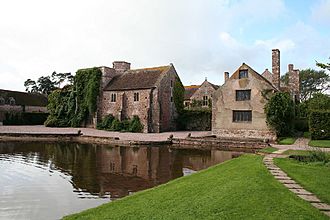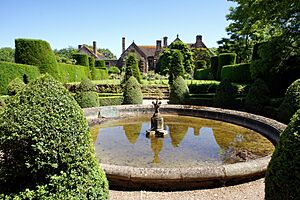Cothay Manor facts for kids
Quick facts for kids Cothay Manor |
|
|---|---|
 |
|
| General information | |
| Architectural style | Medieval |
| Town or city | Stawley, near Wellington |
| Country | England |
| Coordinates | 50°59′01″N 3°18′17″W / 50.9837°N 3.3048°W |
| Completed | c1480 |
Cothay Manor is a beautiful and very old house with lovely gardens in Stawley, near Wellington, Somerset, England. It's a special medieval building, built around 1480. This means it's over 500 years old! The manor grounds are quite large, covering almost 40 acres. They include charming cottages, other buildings, stables, and 12 acres of amazing gardens.
Cothay Manor is considered a Grade I listed building. This means it's one of the most important historic buildings in England. Its old gate pillars and a wall at the north entrance are also protected as Grade II listed structures.
Long ago, in the early 1300s, the de Cothay family owned the manor. Later, the Bluett family took over. They were also important landowners in nearby areas.
When the house was built around 1480, it was a very well-kept collection of buildings. It's still seen as one of the best examples of a small 15th-century country house in England. In medieval times, the rent for the land around the manor was unique: a pair of silver spurs and a rose. To celebrate the end of the Cousins' Wars, the Bluett family planted a red rose and a white rose on the terrace. These roses represented the two sides of the war, coming together in peace.
In 1927, a historian named Christopher Hussey wrote that Cothay Manor was "the most perfect small 15th-century country house that survives in the Kingdom."
A Look at Recent History
In 1925, a man named Lt-Col Reginald Cooper bought Cothay Manor. He was a good friend of Sir Harold Nicolson, who owned another famous garden called Sissinghurst Castle Garden. Cooper worked to restore the house and its gatehouse. He wanted to keep their original medieval look and feel.
Cooper and Nicolson often shared ideas about gardening. Cooper even moved part of the River Tone to protect his favorite pine trees from being washed away! Some garden writers have called Cothay the "Sissinghurst of the West Country" because of its beautiful design.
From 1937 to 1947, Sir Francis Cook, 4th Baronet owned the property. He kept many valuable art pieces there during World War II. After the war, the art was moved.
In 1947, Vera Astley-Rushton bought the house and gardens. She and her daughter, Penelope, opened the house and gardens to the public in the 1960s. They also brought back Catholic worship to Cothay, being the first Catholic family to live there since the Bluett family. They even farmed using organic methods, raising Jersey cows. They sold the property in 1972.
Later, Edward du Cann, a Member of Parliament, owned Cothay. He sold it to Alastair and Mary-Anne Robb in 1993. Mary-Anne's great-grandmother was a plant hunter. A plant called Euphorbia amygdaloides 'var. robbiae' is named after her!
The Robbs worked hard to fix up the whole property and gardens. They rebuilt the gardens, following the original design by Reginald Cooper. They also added new areas, like a bog garden and a wild flower meadow. They planted an Arboretum, which is like a collection of different trees.
In 2003, a book called "England’s Thousand Best Houses" gave Cothay four out of five stars. The author, Simon Jenkins, praised its "incomparable value" and authentic medieval rooms.
Cothay Manor on TV
In 2008 and 2009, Cothay Manor was featured on a TV show called Country House Rescue on Channel 4. The show helped the owners find ways to make more money from visitors. The Robbs said they used some of the advice from the show. They also added their own ideas to make the manor feel more special. Alastair Robb passed away in December 2015, but his family still owns the property.
A book by George Plumptre, "The English Country House Garden: Traditional Retreats to Contemporary Masterpieces," gave a detailed look at the manor's history and its gardens in 2013.
In 2018, Cothay Manor was used as a film set for the movie Dolittle (2020). This movie stars Robert Downey Jr. and is about a doctor who can talk to animals.
In June 2020, Country Life magazine described the manor's medieval rooms. These include the Great Hall, the Great Chamber, the Winter Parlour, the Gold Room, the Guest Chamber, and a tiny chapel called the Oratory. The magazine also mentioned that the manor has many residential buildings.
In early June 2020, the property was put up for sale. It was sold in October 2020 to new owners.
See also
- List of country houses in the United Kingdom



